PM4S Multi-range Timers (Discontinued Products)
Download
-
Discontinued Products
-
Rating/ Performance
-
Dimensions
-
Cautions For Use
Ⅾiscontinued
Last time buy
September 30, 2019
Discontinued Products
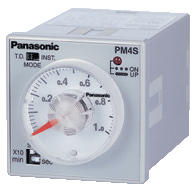
Rating/ Performance
| type | PM4S Multi-range Timer | ||||||
|---|---|---|---|---|---|---|---|
| Item | |||||||
| Rating | Rated operating voltage | 100 to 120V AC | 200 to 240V AC | 12V DC | 24V DC | ||
| Rated frequency | 50/60 Hz | - | |||||
| Rated power consumption | Approx. 3.0VA/3.6VA (at 100V AC) Approx. 4.5VA/5.25VA (at 120V AC) | Approx. 5.6VA/6.8VA (at 200V AC) Approx. 7.5VA/9.8VA (at 240V AC) | Approx1.3W | Approx1.7W | |||
| Output rating | 5A 250V AC (resistive load) | ||||||
| Operating mode | Power ON-delay | ||||||
| Time range | A type | 1s/10s/1min/10min (4 time ranges selectable) | |||||
| B type | 3s/30s/3min/30min (4 time ranges selectable) | ||||||
| C type | 6s/60s/6min/60min (4 time ranges selectable) | ||||||
| D type | 1min/10min/1h/10h (4 time ranges selectable) | ||||||
| E type | 3min/30min/3h/30h (4 time ranges selectable) | ||||||
| Time accuracy Note) | Operating time fluctuation | ±1% (power off time change at the range of 0.1s to 1h) | |||||
| Setting error | ±5% (Full-scale value) | ||||||
| Voltage error | ±1% (at the operating voltage changes between 85 to 110%) | ||||||
| Temperature error | ±2% (at 20°C ambient temp. at the range of 10 to +50°C/ +14 to +122°F) | ||||||
| Contact | Contact arrangement | T.D.: Timed-out 2 Form C INST.: Timed-out 1 Form C, instantaneous 1 Form C (Selected by front switch) | |||||
| Contact resistance (Initial value) | Max. 100m ohm; (at 1A 6V DC) | ||||||
| Contact material | Silver alloy | ||||||
| Life | Mechanical (contact) | Min. 107 | |||||
| Electrical (contact) | Min. 105(at raed control capacity) | ||||||
| Electrical function | Allowable operating voltage range | 85 to 110% of rated operating voltage | |||||
| Insulation resistance (Initial value) | Min. 100Mohm Between live and dead metal parts Between input and output Between contacts of different poles Between contacts of same pole (At 500V DC) | ||||||
| Breakdown voltage (Initial value) | 2,000Vrms for 1 min Between live and dead metal parts 2,000Vrms for 1 min Between input and output 2,000Vrms for 1 min Between contacts of different poles 1,000Vrms for 1 min Between contacts of same pole | ||||||
| Min. power off time | 100 ms | ||||||
| Max. temperature rise | 55°C/ 131°F | ||||||
| Mechanical function | Vibration resistance | Functional | 10 to 55Hz: 1 cycle/min double amplitude of 0.25mm (10min on 3 axes) | ||||
| Destructive | 10 to 55Hz: 1 cycle/min double amplitude of 0.375mm (1h on 3 axes) | ||||||
| Shock resistance | Functional | Min. 98m/s2 (4 times on 3 axes) | |||||
| Destructive | Min. 980m/s2(5 times on 3 axes) | ||||||
| Operating condition | Ambient temperature | -10 to 50°C/ +14 to +122°F | |||||
| Ambient humidity | 30 to 85%RH (non-condensing) | ||||||
| Atmospheric pressure | 860 to 1,060hPa | ||||||
| Ripple factor (DC type) | 20% | ||||||
| Others | Weight | approx. 110g/ 3.880 oz | |||||
*1 Unless otherwise specified, the measurement conditions at the maximum scale time standard are specified to be the rated operating voltage (within 5% ripple factor for DC), 20℃/ 68℉ ambient temperature, and 1s power off time. *2 For the 1s range, the tolerance for each specification becomes ±10ms.
Dimensions
- Unit: mm in
General tolerance : ±0.5 ±0.20

Surface mount dimensions

Panel mount dimensions (with mounting frame)
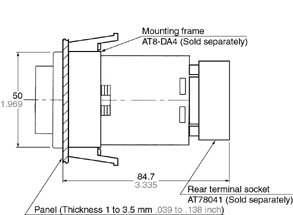
Panel cut out dimensions
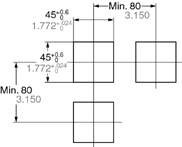
Standard cut out dimensions are shown below.Use mounting frame (AT8-DA4) and rubber gasket (ATC18002).
Adjacent mounting
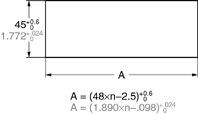
Terminal layouts and wiring diagrams
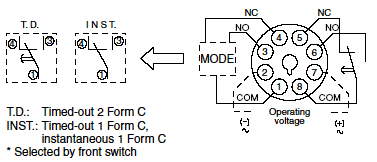
*Operating voltage signs in parentheses ( ) indicate the polarity of the DC type.*is a time delay contact.is an instantaneous contact.
Cautions For Use
Timers Cautions for Use (Common for All Models)
Cautions for circuits
1.Protective circuit for timer contact
In the circuit that switches an inductive load, a contact failure may occur at a contact point due to surge or inrush current resulting from that switching.
Therefore, it is recommended that the following protective circuit be used to protect the contact point.
| Circuit | Application | Features/Others | Device Selection | |||
|---|---|---|---|---|---|---|
| AC | DC | |||||
| CR circuit (r: resistor c: capacitor) |  | * Note: | Available | If the load is a relay or solenoid, the release time lengthens.Effective when connected to both contacts if the power supply voltage is 24 or 48 V and the voltage across the load is 100 to 200 V. | If the load is a timer, leakage current flows through the CR circuit causing faulty operation. Note: If used with AC voltage, be sure the impedance of the load is sufficiently smaller than that of the CR circuit. | As a guide in selecting r and c, c: 0.5 to 1 µF per 1 A contact current r: 0.5 to 1 ohm; per 1 V contact voltage Values vary depending on the properties of the load and variations in timer characteristics. Capacitor c acts to suppress the discharge the moment the contacts open. Resistor r acts to limit the current when the power is turned on the next time. Test to confirm. Use a capacitor with a breakdown voltage of 200 to 300 V. Use AC type capacitors (non-polarized) for AC circuits. |
| - | ||||||
 | Available | Available | ||||
| Diode circuit |  | N/A | Available | The diode connected in parallel causes the energy stored in the coil to flow to the coil in the form of current and dissipates it as joule heat at the resistance component of the inductive load. This circuit further delays the release time compared to the CR circuit.(2 to 5 times the release time listed in the catalog) | Use a diode with a reverse breakdown voltage at least 10 times the circuit voltage and a forward current at least as large as the load current. In electronic circuits where the circuit voltages reverse breakdown voltage of about 2 to 3 times the power supply voltage. | |
| Varistor circuit |  | Available | Available | Using the rated voltage characteristics of the varistor, this circuit prevents excessively high voltages from being applied across the contacts. This circuit also slightly delays the release time. Effective when connected to both contacts if the power supply voltage is 24 or 48 V and the voltage across the load is 100 to 200 V. | - | |
2.Type of Load and Inrush Current
The type of load and its inrush current characteristics, together with the switching frequency are important factors which cause contact welding. Particularly for loads with inrush currents, measure the steady state current and inrush current and use a relay or magnet switch which provides an ample margin of safety. The table below shows the relationship between typical loads and their inrush currents.
| Type of load | Inrush current |
|---|---|
| Resistive load | Steady state current |
| Solenoid load | 10 to 20 times the steady state current |
| Motor load | 5 to 10 times the steady state current |
| Incandescent lamp load | 10 to 15 times the steady state current |
| Mercury lamp load | 1 to 3 times the steady state current |
| Sodium vapor lamp load | 1 to 3 times the steady state current |
| Capacitive load | 20 to 40 times the steady state current |
| Transformer load | 5 to 15 times the steady state current |
When you want large load and long life of the timer, do not control the load direct with a timer. When the timer is designed to use a relay or a magnet switch, you can acquire the longer life of the timer.
3.Connection of input
Since PM4H and LT4H series timers use a transformerless power supply system, the input equipments must have the power supply transformer in which the secondary side is not grounded with the primary and secondary sides insulated, in order to prevent interference of the power supply circuit when connecting the external input circuit as Fig. A.
Be sure not to use an autotransformer. In case of secondary side grounded or using the autotransformer, this product may be destroyed due to short circuit electrically as Fig. B (1 and 2).
In case of F.G. terminal of equipments such a PLC grounded in secondary side of the transformer, inner circuits of this product and the input equipment may be destroyed due to short circuit electrically as Fig.B (3).
Therefore, use the isolated type timers or do not ground F.G. terminal of the products.


4.Long Continuous Current Flow
Long continuous current flow through the timer (approx. one month or longer) cause generation of heat internally, which degrade the electronic parts. Use the timer in combination with a relay and avoid long continuous current flow through the timer.
When using contact output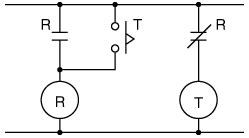

5.Leakage current
- 1.For connecting and disconnecting operating voltage to the timer, a circuit should be used, which will prevent the flow of leakage current. For example, a circuit for contact protection as shown in Fig A. will permit leakage current flow through R and C, causing erroneous operation of the timer. Instead, the circuit shown in Fig. B should be used.

- 2.If the timer is directly switched with a non-contact element, leak current may flow into the timer and cause it to malfunction.
6.Power off time
If the operation voltage for the timer is turned ON after the limit time operation is completed or before the limit time is reached, the Power off time longer than the timer restoration time must be secured.
7.Suicide circuit
If the timer is restored immediately after the specified time is reached, the circuit must be configured so that the restoration time of the timer can be secured sufficiently.
If the power circuit for the timer is turned OFF with the timer contact, a suicide circuit may be configured (Fig. A). In order to settle the problem with this potential suicide circuit, the circuit must be designed so that the timer is turned OFF after the self-retention circuit is completely released (Fig. B).

8.Electrical life
The electrical life varies depending on the load type, the switching phase, and the ambient atmosphere. In particular, the following cases require careful attention:
- 1.If an AC load is switched in synchronized phases:Locking or welding is liable to occur due to contact transposition. Check this with the actual system.
- 2.If a load is switched very frequently:
If a load which generates arcs when a contact is switched is turned ON and OFF very frequently, nitrogen and oxygen in air are combined due to arc energy and then HNO3 is produced. This may corrode metallic materials.
The effective countermeasures include:
- 1.Using an arc-extinguishing circuit;
- 2.Decreasing the switching frequency; and
- 3.Decreasing the humidity in the ambient atmosphere.
9.Pin connections
Correctly connect the pins while seeing the pin layout/connection diagram. In particular, the DC type, which has polarities, does not operate with the polarities connected reverse. Any incorrect connection can cause abnormal heating or ignition.
10.Connection to operation power supply
- 1.Supply voltage must be applied at a time through a switch, a relay, and other parts. If the voltage is applied gradually, the specified time may be reached regardless of its value or the power supply may not be reset.
- 2.The operation voltage for the DC type must be at the specified ripple percentage or less. The average voltage must fall within the allowable operation voltage range.
| Rectification type | Ripple percentage |
|---|---|
| Single-phase, full-wave | Approx. 48% |
| Three-phase, full-wave | Approx. 4% |
| Three-phase, half-wave | Approx. 17% |
- 3.Make sure that no induced voltage and residual voltage are applied between the power pins on the timer after the power switch is turned OFF.
11.Control output
- 1.The load for the control output must be used within the load capacity specified in the rated control capacity. If it is used exceeding the rated value, the life is greatly shortened.
- 2.The following connection might result in short circuit between the heteropolar contacts in the timer.

12.Installing the timer
- 1.To install the timer, use the dedicated pin bracket or socket (cap). Avoid connecting the pins on the timer by directly soldering them.
- 2.In order to maintain the characteristics, do not remove the timer cover (case).
13.Superimposed surge of power supply
For the superimposed surge of power supply, the standard waveform (±1.2×50μs or ±1×40μs) is taken as the standard value for surge-proof voltage.
(The positive and negative voltages are applied each three or five times between the power pins.) For the standard values for the PM4H, LT4H, and S1DX type timers, see the respective items in "Caution on usage."
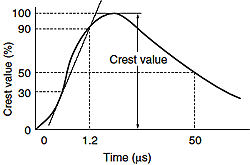
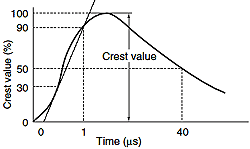
PMH [±(1×40)μs]
| Voltage type | Surge voltage |
|---|---|
| AC type (except 24V AC) | 4,000V |
| 12V, 24V DC, 24V AC | 500V |
Other timers [±(1×40)μs]
| Type | Surge voltage |
|---|---|
| PNS CN-C CHP, CHP-F | 20 times rated voltage |
| CHP-SD | 4,000V |
If external surge occurs exceeding the specified value, the internal circuit may break down. In this case, use a surge absorption element. The typical surge absorption elements include a varistor, a capacitor, and a diode. If a surge absorption element is used, use an oscilloscope to see whether or not the foreign surge exceeding the specified value appears.
14.Changing the set time
Do not change the set time when the limit time operation is in progress.
However, this is possible only with the motor-driven type timer if the set time is shorter than the remaining time. For changing the set time on the digital timer (LT4H), see the relevant item in "Caution on use."
15.Operating environment
- 1.Use the timer within the ambient temperature range from -10°C to +50°C/ +14°F to +122°F (+55°C/ +131°F for the LT4H series) and at ambient humidity of 85% RH maximum.
- 2.Avoid using the timer in a location where (a) inflammable or corrosive gas is generated, (b) the timer is exposed to much dust and other foreign matter; (c) water or oil is splashed on the timer; or (d) vibrations or shocks are given to the timer.
- 3.The timer cover (case), the knobs, and the dials are made of polycarbonated resin. Therefore, prevent the timer from being exposed to organic solvents such as methyl alcohol, benzine, and thinner, strong acid substances such as caustic soda, and ammonia and avoid using the timer in atmosphere containing any of those substances.
- 4.If the timer is used where noises are emitted frequently, separate the input signal elements (such as a sensor), the wiring for the input signal line, and the timer as far as possible from the noise source and the high power line containing noises.
16.Checking the actual load
In order to increase the reliability in the actual use, check the quality of the timer in the actual usage.
17.Others
- 1. If the timer is used exceeding the ratings (operation voltage and control capacity), the contact life, or any other specified limit, abnormal heat, smoke, or ignition may occur.
- 2. If any malfunction of the timer is likely to affect human life and properties, give allowance to the rated values and performance values. In addition, take appropriate safety measures such as a duplex circuit from the viewpoint of product liabilities.
PM4S Multi-range Timers Cautions For Use
- Avoid locations subject to flammable or corrosive gases,excessive dust, oil, vibrations, or excessive shocks.
- Since the main-unit is made of polycarbonate resin, avoid contact with or use in environments containing methyl alcohol, benzene, thinners, and other organic solvents; and ammonia, caustic sodas, and other alkaline substances.
- Power supply superimposed surge protector Although a surge protector will withstand standardwaveform voltage with the values in the next table, anything above this will destroy the internal circuit.
You should therefore use a surge absorber outside.12V DC 24V DC 100 to 120V AC 200 to 240V AC 500V 4,000V Surge waveform [±(1.2×50) μs uni-polar full wave voltage]
- In order to maintain the characteristics, do not remove the timer case.
- When installing the panel, use the AT8-DA4 mounting frame (Sold separately).
- If you change the operating voltage, be sure not to allow leak current into the timer.
- Avoid leaving the unit powered continuously. Leaving the unit powered up with output set to ON continuously for a long period of time (about 1 month or more) will wear out the electronic components. If you will be keeping it powered continuously, combine with a relay to create the circuit shown right:

- The timer setting dial should only be turned within the range indicated on the dial face.
Turning it too far may break the stopper and cause damage to internal components.
Acquisition of CE Marking
Please abide by the conditions below when using in applications that comply with EN61812-1.
- 1.Overvoltage category III, pollution level 2
- 2.The load connected to the output contact should have basic insulation.This timer is protected with basic insulation and can be doubleinsulated to meet EN/IEC requirements by using basic insulation on the load.
- 3.Please use a power supply that is protected by an overcurrent protection device which complies with the EN/IEC standard (example: 250 V 1 A fuse, etc.).
- 4.You must use a terminal socket or socket for the installation. Do not touch the terminals or other parts of the timer when it is powered. When installing or un-installing, make sure that no voltage is being applied to any of the terminals.IEC standard (example: 250 V 1 A fuse,etc.).
- 5.Do not use this timer as a safety circuit. For example when using a timer in a heater circuit, etc., provide a protection circuit on the machine side.